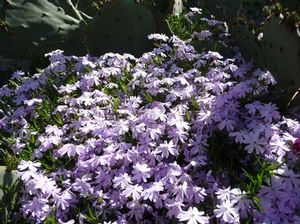Printed at http://www.newmoonnursery.com/index.cfm/
Phlox subulata 'Emerald Blue'
Moss phlox
Native to North America (cultivar)
FIRST IMPRESSIONS: Phlox subulata ‘Emerald Blue’ is a mat forming perennial wildflower cultivar. Plants have evergreen needle-like leaves. In spring foliage is crowned by masses of starry blue-violet flowers. Creeping phlox is a lovely groundcover for sunny gardens with moist well drained soil.
HABITAT & HARDINESS: The parent species Phlox subulata occurs in the eastern United States from Maine to Minnesota and south to Georgia and Louisiana. Plants are indigenous to rocky and sandy barrens, savannas, rocky ledges, slopes and clearings and disturbed sites.
‘Emerald Blue’ is a floriferous cultivar with uniform blue-violet flowers.
Plants are hardy from USDA Zones 3-9.
PLANT DESCRIPTION: Phlox subulata ‘Emerald Blue’ is a diminutive groundcover that forms moss-like mats of evergreen foliage. The trailing stems are green when young turning tan and finally woody and knotty with age.
Leaves are awl shaped with smooth edges and pointed tips. Blades are needlelike and less than 1” long. They are opposite or clustered on the stems and are prickly to the touch.
Fertile stems branch off the trailing stems and terminate in showy flower clusters. The individual flowers are blue-violet with a darker purple ring of markings around the center. Each flower has 5 petals with notched tips that flare from a narrow tube.
Blooming begins in early or mid-spring and continues until early summer. Small inconspicuous oval seed capsules follow.
Flowering stems rise to 4” and plants spread to 18”.
CULTURAL & MAINTENANCE NEEDS: Phlox subulata ‘Emerald Blue’ flourishes in sun or part sun with average or dry well drained soil. Plants tolerate sandy or rocky soil, drought, neutral to slightly alkaline pH and poor infertile soil.
Plants are fairly pest resistant but may have issues with spider mites in hot dry sites. Foliage is somewhat resistant to deer but may be nibbled by rabbits.
As old stems become woody they tend to lose foliage and decline if they are not sheared after flowering to promote new growth.
Plants may be shaded out if crowded by aggressive companions or weeds. In colder zones, this cultivar is likely to be burned by winter winds unless protected by snow cover or an evergreen windbreak.
LANDSCAPE USES: This Groundcover produces colorful spring carpets of blue-violet flowers for Perennial Borders or Rock Gardens. This cultivar is striking if allowed to drape over a low retaining wall. Plants are used as Butterfly Nectar Plants, Erosion Control or as part of a Grouping or Mass Planting. Phlox subulata ‘Emerald Blue’ has Showy Blooms and is appropriate for Cottage Gardens, Water-wise Landscapes and Low Maintenance Plantings.
COMPANION & UNDERSTUDY PLANTS: Try pairing Phlox subulata ‘Emerald Blue’ with Amsonia hubrichtii, Coreopsis major, Echinacea purpurea, Nepeta ‘Walker’s Low’ or Sporobolus heterolepis.
The cultivar ‘Emerald Pink’ has similar appearance and culture and could be substituted in some situations.
TRIVIA: ‘Emerald Blue’ provides valuable early season nectar for swallowtail butterflies, day flying sphinx moths and hummingbirds.
Due to similar growth habit and blooming time, Phlox subulata and Phlox stolonifera are sometimes confused. P. subulata has needle like foliage, flowers with dark eyes and markings toward the center and a preference for sunny dry rocky habitats. P. stolonifera has oblong leaves, flowers with no darker markings and a preference for moist woodland habitats.
Height:
3-4 inSpread:
12-18 inSpacing:
12 inUSDA Hardiness Zone:
3-9Bloom Color:
BluePhlox subulata 'Emerald Blue' Characteristics
Attracts Wildlife
- Butterflies
- Pollinators
Attributes
- Rock Garden
- Naturalizing
- Evergreen
- East-Coast Native
- Drought Tolerant
Exposure
- Full Sun to Partial Shade
Flowering Months
- May
- April
Foliage Color
- Blue-Green
Groundcover Foot-Traffic Tolerances
- Light
Growth Rate
- Medium
Salt Tolerance
- Medium
Season of Interest (Foliage)
- Fall
- Summer
- Spring
- Winter
Soil Moisture Preference
- Moist to Dry

